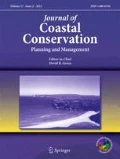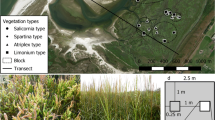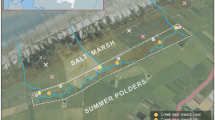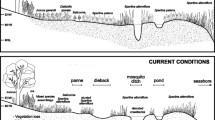Abstract
This paper explores the impact of erosion and restoration measures on habitat development and on wave damping by a small salt marsh nestled alongside a dike on the Wadden island of Terschelling. The aim is to advance knowledge about the benefits and possible side-effects of salt-marsh restoration. Analysis of a time series of aerial photographs from 1944 to 2010 indicates that the salt marsh decreased steadily in size after maintenance of accretion works was terminated. In the western part of the marsh, which is accessible to sheep, vegetation is low (5–15 cm) and dominated by Salicornia europaea and by Spartina anglica. In the most intensively grazed parts, vegetation is very scarce. The eastern, inaccessible part of the salt marsh is covered by dense patches of the shrubby perennial Atriplex portulacoides and Spartina anglica (15–25 cm in height). SWAN wave models show that wave height at this location is significantly affected by the areal extent of the salt marsh as well as by the vegetation. High or dense vegetation are in the models nearly as effective in damping waves (with an initial height of 0.15 and 0.5 m) as widening the salt-marsh area by 350 m. A low density of low plants, as observed in the grazed part of the marsh, has almost no wave-damping effect. Even under conditions of sea level rise, a broader salt marsh vegetated with high plants significantly affects modelled wave height. Therefore, salt-marsh restoration is an adaptation measure worth exploring, though an array of effect types must be considered.











Similar content being viewed by others
References
Adam P (1990) Saltmarsh ecology. Cambridge University Press, Cambridge
Allen JRL (2000) Morphodynamics of holocene salt marshes: a review sketch from the Atlantic and Southern North Sea coasts of Europe. Quat Sci Rev 19(12):1155–1231
Anderson ME, Smith JM, McKay SK (2011) Wave Dissipation by Vegetation. Coastal and Hydraulics Engineering Technical Note ERDC/CHL CHETN-I-82. Vicksburg MS, U.S. Army Engineer Research and Development Center. http://chl.erdc.usace.army.mil.chetn. Cited 5 Nov 2013
Balke T, Klaassen PC, Garbutt A, Van der Wal D, Herman PMJ, Bouma TJ (2012) Conditional outcome of ecosystem engineering: A case study on tussocks of the salt marsh pioneer Spartina anglica. Geomorphology 153–154:232–238
Booij N, Ris RC, Holthuijsen LH (1999) A third generation wave model for coastal regions, part I, model description and validation. J Geophys Res 104(C4):7649–7666
Bonnebaden (1920) Copyright© Dienst voor het kadaster en de openbare registers Apeldoorn. http://metadata.brabant.nl/metadata/TOP.RAS_1920_1929_25_BON_C.xml. Accessed 1 November 2013
Brampton AH (1992) Engineering significance of British saltmarshes. In: Allen JRL, Pye K (eds) Saltmarshes: morphodynamics, conservation and engineering significance. Cambridge University Press, Cambridge, pp 115–122
Braun-Blanquet J (1928) Planzensoziologie: Grundzüg der Vegetationskunde. Biologische studienbücher VII. Springer, Berlin
Bruggeman W, Dammers E, Van den Born GJ, Rijken B, Van Bemmel B, Bouwman A, Nabielek K, Beersma J, Van Den Hurk B, Polman N, Linderhof V, Folmer C, Huizinga F, Hommes S, Te Linde A (2013) Deltascenario’s voor 2050 en 2100, nadere uitwerking 2012–2013. Ministry of Infrastructure and Environment, The Hague
Chen Y, Thompson CEL, Collins MB (2012) Saltmarsh creek bank stability: biostabilisation and consolidation with depth. Cont Shelf Res 35:64–74
Costanza R, Pérez-Maqueo O, Martinez ML, Sutton P, Anderson SJ, Mulder K (2008) The value of coastal wetlands for hurricane protection. Ambio 37(4):241–248
Cox R, Wadsworth RA, Thomson AG (2003) Long-term changes in salt marsh extent affected by channel deepening in a modified estuary. Cont Shelf Res 23(17–19):1833–1846
CWSS (1997) Stade declaration: trilateral Wadden Sea plan, eighth trilateral governmental conference on the protection of the Wadden Sea. Common Wadden Sea Secretariat, Wilhelmshaven
De Groot AV, Van Wesenbeeck BK, Van Loon-Steensma JM (2012) Stuurbaarheid van kwelders. IMARES, Den Burg
De Jong F, Bakker J, Van Berkel K, Dankers N, Dahl K, Gatje C, Marencic H, Potel P (1999) Wadden Sea quality status report. Wadden Sea Ecosyst 9:1–259
Decuyper M, Slim PA, Van Loon-Steensma JM (2014) Dendrochronology of Atriplex portulacoides and Artemisia maritima in Wadden Sea salt marshes. J Coast Conserv 18(3):279–284
Dijkema KS, Van Duin WE, Dijkman EM, Van Leeuwen PW (2007) Monitoring van Kwelders in de Waddenzee: rapport in het kader van het WOT programma Informatievoorziening Natuur i.o. (WOT IN). Alterra, Wageningen
Dirkse GM (1998) The validity of general purpose flora-based classification of vegetation. IBN Scientific Contributions 14. IBN-DLO, Wageningen
Doing H (1995) Landscape ecology of the Dutch coast. J Coast Conserv 1(2):145–172
Donkersloot-de Vrij M (2002) ‘Scellinge’: vijf eeuwen kartografie van Terschelling. Matrijs, Utrecht
Dormann CF, Van der Wal F, Bakker JP (2000) Competition and herbivory during salt marsh succession: the importance of forb growth strategy. J Ecol 88(4):571–583
Elias E (2006) Morphodynamics of Texel inlet: morfodynamica van het zeegat van Texel. Dissertation, Technical University Delft
Essink K, Dettmann C, Farke H, Laursen K, Luersen G, Marencic H, Wiersinga W (2005) Wadden Sea quality status report 2004. Wadden Sea Ecosyst 19:1–359
European Commission (2007) Interpretation manual of European Union habitats, EUR 27. European Commission DG Environment, Brussels
Feagin RA, Lozada-Bernard SM, Ravens TM, Möller I, Yeager KM, Baird AH (2009) Does vegetation prevent wave erosion of salt marsh edges? Proc Natl Acad Sci U S A 106(25):10109–10113
Gorter R, Muiser G (1994) Het waterschap ‘de Terschellingerpolder’: twee eeuwen strijd tegen water. Waterschap Friesland, afdeling Terschelling, Leeuwarden
Habitats Directive (1992) Council directive 92/43/EEC of 21 May on the conservation of natural habitats and of wild fauna and flora. Official J Eur Commun 206 22/07/1992
Hasselmann K, Barnett TP, Bouws E, Carlson H, Cartwright DE, Enke K, Ewing JA, Gienap H, Hasselmann DE, Kruseman P, Meerburg A, Müller P, Olbers DJ, Richter K, Sell W, Walden H (1973) Measurements of wind-wave growth and swell decay during the Joint North Sea Wave Project (JONSWAP). Dtsch. Hydrogr. Z. Suppl. 12, A8
Hennekens SM, Schaminée JHJ (2001) Turboveg, a comprehensive database management system for vegetation data. J Veg Sci. www.synbiosys.alterra.nl/turboveg/ Accessed 2 September 2013
Hu Z, Suzuki T, Zitman T, Uittewaal W, Stive M (2014) Laboratory study on wave dissipation by vegetation in combined current-wave flow. Coast Eng. doi:10.1016/j.coastaleng.2014.02.009
Janssen JAM, Schaminée JHJ (2003) Europese natuur in Nederland: Habitattypen . KNNV, Utrecht
Kiehl K, Eischeid I, Gettner S, Walter J (1996) Impact of different sheep grazing intensities on salt marsh vegetation in northern Germany. J Veg Sci 7(1):99–106
King SE, Lester JN (1995) The value of salt marsh as a sea defence. Mar Pollut Bull 30(3):180–189
Kirwan ML, Guntenspergen GR, D’Alpaos A, Morris JT, Mudd SM, Temmerman S (2010) Limits on the adaptability of coastal marshes to rising sea level. Geophys Res Lett 37(23):L23401
Ministry of Transport, Public Works and Water Management, National Institute for Coastal and Marine Management and Rijksinstituut voor Integraal Zoetwaterbeheer en Afvalwaterbehandeling (2007) Hydraulische randvoorwaarden primaire waterkeringen: voor de derde toetsronde 2006–2011 (HR 2006). Ministry of Transport, Public Works and Water Management, The Hague
Ministerie van Economische Zaken Landbouw & Innovatie (2011) Gebiedendocumenten Natura 2000 Gebieden [in Dutch]. Report, The Hague http://www.synbiosys.alterra.nl/Natura2000/gebiedendatabase.aspx?subj¼n2k&groep¼2&id¼n2k1&topic¼documenten. Accessed 1 November 2013
Mol ACS (2004) Wave attenuation by vegetation. WL Delft Hydraulics Report Z2837/Z3040, Delft
Möller I, Spencer T, French JR, Legett DJ, Dixon M (1999) Wave transformation over salt marshes: a field and numerical modelling study from North Norfolk, England. Estuar Coast Shelf Sci 49:411–426
Möller I, Spencer T, French JR, Leggett DJ, Dixon M (2001) The sea-defence value of salt marshes: field evidence from North Norfolk. J Chart Inst Water Environ Manag 15(2):109–116
Nepf HM (2011) Flow over and through biota. In: Wolanski E, McLusky D (eds) Treatise on estuarine and coastal science. Academic, Waltham, pp 267–288
Olff H, De Leeuw J, Bakker JP, Platerink RJ, Van Wijnen HJ, De Munck W (1997) Vegetation succession and herbivory in a salt marsh: changes induced by sea level rise and silt deposition along an elevational gradient. J Ecol 85:799–814
Reise K, Baptist M, Burbridge P, Dankers N, Fischer L, Flemming B, Oost AP, Smit C (2010) The Wadden Sea: a universally outstanding tidal wetland. Wadden Sea Ecosystem No. 29. Common Wadden Sea Secretariat, Wilhelmshaven, pp 7–24
Sanders ME, Slim PA, Wegman RMA (2005) Monitoring kwelderrand Oerderduinen. In: Begeleidingscommissie Monitoring Bodemdaling Ameland (ed.) Monitoring effecten van bodemdaling op Ameland-Oost: evaluatie na 18 jaar gaswinning. Begeleidingscommissie Monitoring Bodemdaling Ameland, Assen, pp 1–52
Schaminée JHJ, Weeda EJ, Westhoff V (1998) De vegetatie van Nederland, deel 4, plantengemeenschappen van de kust en van binnenlandse pioniersmilieus. Opulus Press, Uppsala & Leiden
Slim PA, Wegman RMA, Sanders ME, Huiskens HPJ, Van Dobben HF (2011) Monitoring kwelderrand Oerderduinen: onderzoek naar de effecten van bodemdaling door gaswinning op de morfologie en vegetatie van de kuststrook ten zuiden van Het Oerd en de Oerderduinen op Oost-Ameland. In: Begeleidingscommissie Monitoring Bodemdaling Ameland (ed.) Monitoring effecten van bodemdaling op Ameland-Oost: evaluatie na 23 jaar gaswinning, deel 1. Begeleidingscommissie Monitoring Bodemdaling Ameland, Assen, pp 125–176
Spencer KL, Harvey GL (2012) Understanding system disturbance and ecosystem services in restored saltmarshes: integrating physical and biogeochemical processes. Estuar Coast Shelf Sci 106:23–32
Suzuki T, Zijlema M, Burger B, Meijer MC, Narayan S (2011) Wave dissipation by vegetation with layer schematization in SWAN. Coast Eng 59:64–71
Van der Meijden R (2005) Heukels’ flora van Nederland. Wolters-Noordhoff, Groningen & Houten
Van der Westhuysen AJ, De Waal JP (2008) Observed finite depth wave growth limit in the Wadden Sea, SBW Wadden Sea. Deltares, Delft
Van Duin WE, Dijkema KS (2012) Randvoorwaarden voor kwelderontwikkeling in de Waddenzee en aanzet voor een kwelderkansenkaart. IMARES Wageningen UR, Den Helder
Van Loon-Steensma JM (2011) Kweldervorming langs de Terschellinger Waddendijk: een verkenning naar kansen, beperkingen en vragen rond kweldervorming langs de Waddendijk e.o. van Terschelling. Alterra, Wageningen
Van Loon-Steensma JM, Slim PA (2013) The impact of erosion protection by stone dams on salt-marsh vegetation on two Wadden Sea barrier islands. J Coast Res 29(4):783–796
Van Loon-Steensma JM, Vellinga P (2013) Trade-offs between biodiversity and flood protection services of coastal salt marshes. Curr Opin Environ Sustain 5(3–4):320–326. doi:10.1016/j.cosust.2013.07.007
Van Loon-Steensma JM, Slim PA, Vroom J, Stapel J, Oost AP (2012) Een dijk van een kwelder: een verkenning naar de golfreducerende werking van kwelders. Alterra, Wageningen
Van Tongeren O, Gremmen N, Hennekens SM (2008) Assignment of relevés to pre-defined classes by supervised clustering of plant communities using a new composite index. J Veg Sci 19:525–536
Van Wijnen HJ, Bakker JP, De Vries Y (1997) Twenty years of salt marsh succession on a Dutch coastal barrier island. J Coast Conserv 3(1):9–18
CWSS (Common Wadden Sea Secretariat) (1991) The Wadden Sea status and developments in an international perspective. Report to the sixth Governmental Conference on the Protection of the Wadden Sea. National Forest and Nature Agency, the Ministry of the Environment, Denmark and Common Wadden Sea Secretariat, Wilhelmshaven
Wolff WJ (ed) (1983) Ecology of the Wadden Sea. Balkema, Rotterdam
Yang SL, Shi BW, Bouma TJ, Ysebaert T, Luo XX (2012) Wave attenuation at a salt marsh margin: a case study of an exposed coast on the Yangtze Estuary. Estuar Coasts 35:169–182
Acknowledgments
This work was supported by the Knowledge for Climate Programme (Theme 1) and the Strategic Knowledge Programme ‘Sustainable Spatial Development of Ecosystems, Landscapes, Seas and Regions’ of the Dutch Ministry of Economic Affairs, Agriculture and Innovation (Theme 14). Furthermore we thank Albert Kiers and Nynke Hamstra for their help, and the anonymous reviewer for the very helpful suggestions.
Author information
Authors and Affiliations
Corresponding author
Electronic supplementary material
Below is the link to the electronic supplementary material.
ESM 1
(DOC 57.0 kb)
Rights and permissions
About this article
Cite this article
van Loon-Steensma, J.M., Slim, P.A., Decuyper, M. et al. Salt-marsh erosion and restoration in relation to flood protection on the Wadden Sea barrier island Terschelling. J Coast Conserv 18, 415–430 (2014). https://doi.org/10.1007/s11852-014-0326-z
Received:
Revised:
Accepted:
Published:
Issue Date:
DOI: https://doi.org/10.1007/s11852-014-0326-z




